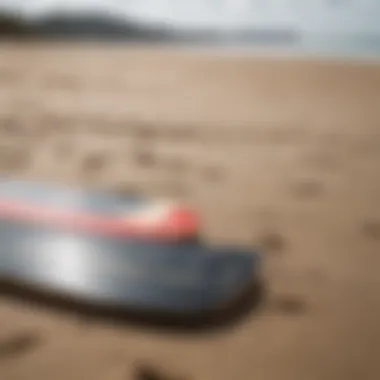Exploring the Armstrong Board in Kiteboarding


Intro
Kiteboarding combines the thrill of surfing with the grace of aerial maneuvers, and at the heart of this exhilarating sport lies the Armstrong Board. For both newcomers and seasoned riders, understanding the intricacies of this equipment can make a world of difference in your performance on the water. The Armstrong Board isn't simply a piece of gear; it's a carefully crafted tool that influences everything from speed to stability. Whether you’re taking your first steps into kiteboarding or you’re an experienced practitioner looking to refine your skills, knowing what makes this board tick is crucial.
This article will delve into the Armstrong Board's design, analyzing how it affects riding performance. We aim to equip you with insights that will enhance your kiteboarding experiences, making every session on the water a notch above the last.
Equipment Insights
Gear Reviews
When evaluating kiteboarding equipment, innovation often stands out, and the Armstrong Board exemplifies this in many aspects. From the carefully chosen materials to the unique shape, every feature serves a purpose.
- Construction: Armstrong Boards use a blend of high-quality carbon fiber and durable foam. This not only keeps the board lightweight but also enhances its responsiveness.
- Shape and Design: The board's outline is designed for optimal glide, making it easier to catch the wind and ride smooth over choppy waters.
- Fin Configuration: Most Armstrong Boards come with adjustable fins that allow riders to tweak their setup according to local conditions. This flexibility can lead to significant performance gains.
Whether riding in flat water or tackling waves, there’s a board configuration to maximize your potential. It’s essential to know your riding style and environment before making a purchase.
Essential Gear Maintenance
Keeping your Armstrong Board in tip-top shape can extend its lifespan and maintain its performance. Here are some key tips for maintenance:
- Regular Cleaning: After each session, rinse the board with fresh water to remove salt and sand. This prevents buildup that could affect performance.
- Check for Dings: Inspect the board for cracks or scratches. Small damages, if left unattended, can widen and affect its integrity.
- Store Properly: When not in use, store your board in a climate-controlled environment. This prevents warping and keeps the materials from degrading.
Remember, a well-maintained board translates to better performance and safer riding experiences.
Technique Exploration
Beginner Techniques
If you’re just starting with the Armstrong Board, here are some foundational techniques to get you on your way:
- Stance: Keep your knees slightly bent and your feet hip-width apart. This will help with balance as you ride.
- Starting: Practice getting up on the board in shallow water. It’s all about finding the right timing with the kite.
- Edging: Learning how to edge properly is critical. This allows you to control your speed and direction effectively.
Advanced Maneuvers
For the more experienced riders looking to step up their game, finesse on the Armstrong Board can open doors to advanced tricks:
- Jumping: To jump, generate speed while edging hard, then quickly pull the kite up. This combination can result in improved hang-time and smooth landings.
- Transitions: Techniques for smooth turns and direction changes can elevate your performance. Practice shifting your weight and keeping speed during transitions.
- Tricks: Once comfortable, you can experiment with spins and grabs, challenging your skills further.
As you develop your techniques, the board’s design will enhance your abilities, turning potential into achievement.
Prelude to the Armstrong Board
In today's fast-paced world of kiteboarding, the right equipment can make all the difference between an exhilarating ride and a frustrating experience. The Armstrong Board holds a prominent spot in the hearts of both novices and seasoned professionals alike, thanks to its cutting-edge design and performance capabilities. Within this exploration, we will dissect not just what this board can do, but why understanding its intricacies matters to riders of all levels.
Historical Background of Kiteboarding Boards
Kiteboarding has come a long way since its inception. The boards initially used were fairly rudimentary, often comparable to hybrids of surfboards and wakeboards. Early kiteboards had limited functionality, leading to a steep learning curve. As demand grew in the 1990s, manufacturers began to innovate—chopping and changing shapes, sizes, and materials. The Armstrong Board arose from this crucible of creativity.
Several key advancements have markedly altered the landscape of kiteboarding boards:
- Material Evolution: From wooden boards to cutting-edge composites that are lighter and more resilient.
- Shape Innovation: Designs have transformed, allowing for increased maneuverability and speed.
- Fin Systems: The introduction of variable fin setups allows pilots to customize rides based on conditions and skill level.
Understanding this historical context informs us why certain design choices are made today in modern boards, especially the Armstrong.
Overview of the Armstrong Brand
Armstrong, as a brand, has carved out a niche that emphasizes quality and performance. Founded with a clear vision, it strives to blend scientific research with the artistry of design. What sets Armstrong apart are its relentless pursuit of innovation and commitment to rider satisfaction. For instance, Armstrong has a reputation for rigorous testing, ensuring that every board meets the high standards demanded by professionals.


- Customer-Centric Philosophy: Armstrong prioritizes feedback from users, making adjustments that reflect the desires and needs of the kiteboarding community.
- Innovative Designs: Each board is tailored for specific riding styles, whether it’s freestyle, all-around, or specialized conditions.
- Sustainability Initiatives: Their commitment to eco-friendly materials and practices resonates with a growing number of environmentally conscious riders.
As kiteboarding continues to evolve, Armstrong Boards signify a blend of tradition and technology, ensuring that both craftsmanship and performance remain front and center in kiteboarding discussions.
"In kiteboarding, the board is not just a tool. It's an extension of the rider. Understanding your board's design can elevate your experience on the water."
This is merely an introduction. The deeper we dive into the specific attributes of the Armstrong Board, the clearer it becomes how it enhances a rider’s journey across the waves.
Design Features of the Armstrong Board
The design features of the Armstrong Board play a pivotal role in determining its performance and usability for kiteboarders. Various elements of the board, from its materials to its shape, influence how riders interact with the wind and water. Each design choice has its own benefits and considerations, making it crucial for riders to understand these features to get the most out of their experience. The beauty of the Armstrong Board lies not just in its aesthetics but also in the engineering that goes into creating a piece of equipment capable of enhancing every single ride.
Materials and Construction Techniques
When it comes to kiteboarding boards, the choice of materials and construction techniques can’t be overlooked. The Armstrong Board often utilizes carbon fiber and epoxy resin, a combo that not only makes it lightweight but also ensures durability. Riders who are keen on performance will appreciate how this mix provides the board with superior stiffness while also minimizing flex.
- Lightweight Yet Strong: The use of carbon fiber significantly reduces the weight without compromising on strength. This is particularly advantageous when up against strong winds.
- Water Resistant: The epoxy resin provides a near-impermeable seal, ensuring that the board remains buoyant and free from waterlogging, prolonging its lifespan.
- Impact Resistance: The construction techniques employed also focus on crash resilience, allowing for rough landings without damaging the board.
One thing to note, however, is that while these materials elevate performance, they tend to come with a higher price tag. Riders should weigh the benefits against their budget and level of commitment.
Shape and Size Variations
The shape and size variations of the Armstrong Board cater to a range of riding styles and conditions. The board comes in different lengths and widths, which influence how a rider glides over the water. A wider board generally offers more stability, making it suitable for beginners, while a narrower one enhances speed and performance for advanced riders.
- Big Boards for Better Floatation: Beginners or those riding in lighter winds may find larger boards beneficial for ease of use.
- Manoeuvrability with Smaller Boards: Advanced riders often prefer smaller boards as they allow for quick turns and aerial tricks.
Additionally, designs may include concave shapes which aid in grip and reduce drag. Riders are encouraged to consider their personal style and the conditions in which they typically ride; this will greatly impact their choice in board shape.
Fin and Tail Configurations
Fin and tail configurations add yet another layer of customization to the Armstrong Board. These components are essential for enhancing performance attributes such as tracking, maneuverability, and stability.
- Fins: Depending on their shape and size, fins can either help to increase grip on the water or facilitate smoother transitions when turning. If you’re into aggressive carving, fins with more edge might serve you well.
- Tail Design: The tail can also be shaped variably. For example, a square tail can maximize pop off the water while a rounded tail might lend to smoother transitions during landing.
Ultimately, understanding how these features work in harmony with the rider's intent is vital. As preferences differ vastly between individuals, experimenting with different setups can lead to an optimal riding experience.
"The right board can mean the difference between a frustrating ride and an exhilarating one." – Anonymous Rider
Performance Characteristics
When it comes to kiteboarding, the performance characteristics of the board you're riding can make all the difference in your experience on the water. The Armstrong Board is designed with particular attention to these characteristics. This section delves into how speed, maneuverability, stability, and rider response interact to create a superior kiteboarding experience. For enthusiasts, understanding these elements can enhance not just performance but also enjoyment while riding, be it in flat water or choppy conditions.
Speed and Maneuverability
Speed is a critical component when it comes to kiteboarding. The Armstrong Board is renowned for its ability to cut through the water with impressive velocity. This speed enables riders to cover larger distances in a shorter amount of time, which is vital for those who want to maximize their time on the water. Additionally, speed translates into improved jumping capabilities. Riders can achieve higher jumps and longer airtime, provided they master the technique.
Maneuverability, on the other hand, describes how easily a rider can change directions or perform tricks. The design of the Armstrong Board incorporates a responsive rocker line and finely tuned rail shapes. This not only allows for quick direction changes but also smooth transitions between turns. A board that feels lively and quick increases confidence in riders, letting them push their limits without fear of losing control. In terms of overall performance, speed and maneuverability on the Armstrong Board go hand in hand, offering an exhilarating ride for those looking to carve their own path on the waves.
Stability and Control in Various Conditions
Stability is paramount, especially when conditions get rough or unpredictable. The Armstrong Board excels in this area due to its design, which includes ample width and a well-considered bottom shape. This provides a stable platform that helps keep the rider balanced, promoting better control. Riders often find that they can handle choppy water conditions more effectively with the Armstrong Board than with other boards that may feel jittery.
Control is equally important. When you're zooming along the water or taking off for a jump, having a solid grip on your board allows for more confident riding. Whether it's gusty winds or shifting tides, the Armstrong Board’s features are built to offer the kind of straightforward control that attracts seasoned pros and novices alike. It’s not just about staying upright—it’s about crafting your ride, feeling every shift, and being able to react intuitively.
"In my experience, riding with the Armstrong Board in turbulent conditions feels like having a reliable partner. You anticipate the next wave and your board just responds as if it’s in sync with you."
Response to Rider Input


The responsiveness of a board to rider input can provide an immediate connection between rider and water. With the Armstrong Board, feedback is crisp and immediate. This means that small shifts in weight or subtle steering inputs lead to immediate reactions. For instance, when a rider leans into a turn, the board reacts almost instantly, allowing for a more engaged riding experience.
This characteristic hugely benefits both beginners and professionals. New riders can learn to gauge their weight distribution and steering by feeling the board's response. Meanwhile, advanced riders can execute tricks and maneuvers with a higher degree of precision.
Ultimately, the performance characteristics—speed and maneuverability, stability and control in various conditions, and response to rider input—distinguish the Armstrong Board in the competitive kiteboarding landscape. Understanding these elements equips riders to make informed choices to enhance their kiteboarding adventure.
Comparison with Other Kiteboarding Boards
When venturing into the world of kiteboarding, one important conversation arises: How does the Armstrong Board stack up against other boards on the market? Understanding these comparisons can give kiteboarding enthusiasts insights not only into the strengths of the Armstrong brand but also into the variety of choices available to meet differing needs. A thorough examination of this subject reveals benefits, considerations, and crucial elements that aspiring riders should know.
The landscape of kiteboarding equipment is vast, with myriad designs and functionalities. Riders often face decisions that impact their performance and enjoyment. Thus, recognizing the nuances of various boards can be the difference between a stellar session on the water and one that leaves much to be desired.
Similar Brands and Models
When comparing the Armstrong Board with others, it’s useful to explore alternative brands and their offerings.
- Naish: Known for its high-quality construction and performance-oriented designs, Naish boards often prioritize speed and agility. Riders seeking thrill might gravitate towards this brand as a compelling competitor.
- Slingshot: With a reputation for innovation, Slingshot boards feature unique designs and are tailored toward those who seek versatility on the water. Many riders appreciate their intuitive handling and distinct tail shapes.
- Duotone: This brand is celebrated for its user-friendly options that cater to beginners and experienced riders alike. Duotone boards often provide stability and ease of use, making them a popular choice in lessons or casual sessions.
Each of these brands encapsulates different aspects of kiteboarding—speed, innovation, or stability. When weighing these options against the Armstrong Board, one must consider personal preferences and riding styles. A board’s shape, size, and build material can result in vastly different riding experiences, ultimately influencing a rider's choice.
Performance Metrics and User Feedback
User feedback acts as a vital compass for evaluating how the Armstrong Board performs relative to others. Performance metrics often cited include speed, stability, and maneuverability. Here’s a closer look at what riders generally say:
- Speed: Riders frequently note that the Armstrong Board delivers impressive speed, especially in favorable wind conditions. This feature might appeal more to advanced users seeking to push their limits.
- Stability: A common sentiment among newbies is that the Armstrong Board feels stable on the water, inspiring confidence for those still honing their skills. Riders highlight how this stability translates into a more enjoyable experience, especially when trying new tricks.
- Maneuverability: Many kiteboarders love the responsiveness of the Armstrong Board. It allows them to swiftly change directions, making it a favorite for freestyle tricks.
"Riding the Armstrong Board transformed my sessions entirely. Its balance of speed and stability really enhances my confidence on the water!"
Assembling feedback and performance stats offers crucial insights but analyzing them alongside direct comparisons with other brands showcases whether the Armstrong Board truly meets riders’ needs.
User Experiences
User experiences play a pivotal role in understanding the effectiveness and satisfaction derived from the Armstrong Board in kiteboarding. As enthusiasts take to the waves, their feedback becomes invaluable in painting a comprehensive picture of the board's performance, enhancing its design, and addressing areas for improvement. Recreational riders and professional kiteboarders alike share insights that highlight the real-world impact of the Armstrong Board on their riding experience.
Testimonials from Recreational Riders
Recreational riders often provide a wealth of knowledge regarding the Armstrong Board's functionality in everyday conditions. They come from diverse backgrounds, each bringing unique perspectives shaped by their individual riding experiences. Many riders state that the board just feels right under their feet. This subjective sensation is of utmost importance, as it directly influences a rider's confidence and overall enjoyment.
For instance, one rider noted, "I remember my first session on the Armstrong Board; it was like I could feel every ripple of the water. The responsiveness was amazing." Such sentiments reflect the board's design prowess and adaptability.
Additionally, users frequently discuss how the board performs in varying wind conditions. One testimonial highlighted, "On lighter wind days, I felt like I wasn't missing any energy. The Armstrong kept me gliding smoothly across the surface, almost effortlessly." This speaks volumes about the board's capabilities and the thorough engineering behind its design.
Here are some key benefits recreational riders mention:
- Ease of Use: Many find it accessible for beginner riders while still providing enough challenge for more advanced levels.
- Versatile Performance: The board shows promising versatility across multiple conditions, including choppy waters and light to moderate winds.
- Comfort: Riders enjoy the board’s ability to reduce fatigue during longer sessions, thanks to its good ergonomic design.
Insights from Professional Kiteboarders
The perspectives of professional kiteboarders shine a light on the Armstrong Board's capabilities at a higher level of performance. Unlike recreational riders, professionals often balance their need for performance with the board's responsiveness to technical maneuvers. It’s not just about cruising; they seek boards that can handle aggressive tricks and provide excellent control during aerial stunts.
One professional rider remarked, "The Armstrong Board allows me to push the limits without worrying about instability. It reacts so quickly, making rotations and transitions smooth. That gives me confidence when trying new tricks."
Another pro emphasized the significance of the construction, stating, "The lightweight material makes a big difference, especially when I’m trying to hit the big waves. It feels like the board just floats beneath me."
When evaluating the Armstrong Board, professional riders particularly focus on the following aspects:
- Durability: They often point out how the board’s resilience withstands the wear-and-tear of serious riding.
- Performance Metrics: The speed and agility are frequently highlighted; they demand a board that not only performs in numerous conditions but also allows for precise control during complex maneuvers.
- Customizability: Professionals appreciate the ability to alter fin setups to enhance performance based on their style of riding.


"Ultimately, the Armstrong Board stands out for its unique blend of agility and stability, allowing me to keep achieving new heights in my performance."
Maintenance and Care for the Armstrong Board
Taking care of your Armstrong Board is not just about keeping it looking sharp, it’s about ensuring consistent performance and longevity. Like any piece of gear that comes into contact with saltwater and sand, a kiteboarding board faces a barrage of potential wear and tear. Neglecting maintenance can lead to costly repairs or an underwhelming riding experience. Therefore, understanding the essentials of maintaining your board is vital—it pays off when you hit the waves.
Cleaning and Storage Recommendations
Maintaining the cleanliness of your Armstrong Board is crucial. After every session, rinse it off with fresh water to wash away salt, sand, and other debris. Salt can corrode materials and affect the performance, making this simple step worth your while.
- Rinse with Fresh Water: Make a habit of rinsing your board after every ride. Aim for a thorough soak, making sure to pay close attention to the fins and any crevices where sand can accumulate.
- Use a Soft Cloth: After rinsing, wipe the board down with a soft towel. This prevents water spots and keeps the board looking brand new.
- Air Dry: Don’t leave the board in direct sunlight for too long, as it can lead to fading and weaken the materials over time. Instead, let it air dry in a shaded or well-ventilated area.
- Storing for Long-Term: When the season winds down or if you’re putting your gear up for an extended break, make sure to store the board in a bag designed for kiteboards. This keeps it safe from scratches and UV damage.
Repair Tips and Tricks
Even with the best care, sometimes wear and tear is unavoidable. Addressing repairs promptly can be the difference between a quick fix and a board that’s out of commission. Here are some handy suggestions:
- Inspect Regularly: Keep an eye on your board for any signs of damage, like chips or cracks. The sooner you identify an issue, the easier it may be to fix.
- Patch it Up: For minor dings, consider using a repair kit specifically designed for kiteboards. It usually includes resin and fiberglass patches that are straightforward to apply.
- Fins and Tail Replacement: If you notice that your fins are showing signs of damage or warping, don't hesitate to replace them. Good fins mean better performance.
- Balance Repair with Professional Help: In cases of major damage, reaching out to a professional might be necessary. This can save you from intorducing further issues and ensure the board stays in shape.
"A well-maintained board is your best ally out there; it’s not just about style, it’s about substance."
Taking the time to clean and maintain your Armstrong Board can enhance your performance on the water substantially. And, staying vigilant about repairs ensures that your board remains your trusted companion during your kiteboarding adventures.
Future Innovations in Kiteboarding Boards
The kiteboarding industry is constantly evolving, with advancements in technology and design playing a crucial role in enhancing the overall riding experience. This section delves into the future innovations that are poised to reshape kiteboarding boards, including the Armstrong Board. Understanding these developments is essential for both enthusiasts and professionals who seek to stay ahead of the curve in this dynamic sport.
The importance of exploring future innovations cannot be overstated. As kiteboarding continues to gain popularity, manufacturers are under pressure to deliver products that enhance performance, comfort, and sustainability. Key innovations not only improve the user experience but also have the potential to address broader environmental concerns as the industry grapples with its ecological footprint.
Technological Advances on Horizon
Numerous technological advancements are stirring excitement among kiteboarding devotees. These include:
- Smart Sensors: The introduction of boards equipped with smart sensors can collect data on performance metrics like speed, jumping height, and technical maneuvers. This information can be critical for improving techniques and tailoring gear to individual riding styles.
- Nano-Composite Materials: Emerging materials such as nano-composites are gaining traction. These materials offer increased durability while significantly reducing weight. Lighter boards can boost agility, making turns sharper and jumps higher.
- Integrated Power Generation: Imagine a board that harnesses wind and converts it into usable energy. Such innovations would allow riders to charge their devices while shredding waves, a feature that would resonate well with the tech-savvy audience.
These technological advances speak to a future where kiteboarding is not just about the thrill of riding, but also leveraging cutting-edge technology to enhance performance and safety. As these technologies become available, kiteboarders can expect their riding experiences to transform completely.
Sustainability and Eco-Friendly Designs
Sustainability is no longer an afterthought; it's now woven into the very fabric of kiteboarding design, especially for forward-thinking brands like Armstrong. As more kiteboarders become environmentally conscious, innovations that address sustainability are paramount. Some noteworthy trends include:
- Recycled Materials: The move towards using recycled materials in board production is gaining momentum. For instance, incorporating recycled plastics not only reduces waste but also lowers the carbon footprint of the manufacturing process.
- Biodegradable Components: Some manufacturers are experimenting with biodegradable materials, which dissolve back into the environment over time. This could minimize the long-term impact of discarded boards.
- Eco-Friendly Adhesives and Finishes: The shift towards using eco-friendly adhesives in board construction and natural finishes is crucial in reducing harmful emissions. Riders can now enjoy their sport without feeling guilty about contributing to environmental degradation.
- Education and Advocacy: Innovative brands are also focusing on educational campaigns that raise awareness about environmental issues within the kiteboarding community. These initiatives can encourage more riders to adopt sustainable practices.
By prioritizing environmentally friendly designs and manufacturing processes, companies can meet consumer demands for sustainability while paving the way for a greener future in kiteboarding.
"The evolution of kiteboarding is a reflection of our changing world. Embracing technology and sustainability will define the next wave of kiteboarding innovations."
In summary, the future of kiteboarding boards, including the Armstrong Board, is brimming with possibilities driven by technological advancements and a commitment to sustainability. Riders can look forward to a more enhanced, enjoyable, and responsible kiteboarding experience.
Epilogue
In the rapidly evolving world of kiteboarding, the Armstrong Board stands out as a critical element for both novice and experienced riders alike. Throughout this article, we've explored various dimensions of the board: from its innovative design and performance characteristics to user experiences and care techniques. Each aspect contributes to a deeper understanding of how the Armstrong Board can enhance your kiteboarding experience.
Understanding the performance metrics of the Armstrong Board is not merely for the technical enthusiast. It’s important for every kiteboarder, as the right choice can significantly affect their ride—be it in the surf, flat water, or challenging conditions. This board's ability to excel across various environments is a testament to its thoughtful engineering and design.
Recap of Key Insights
- Performance Varieties: The board excels in speed and maneuverability, offering control that adapts well to different rider inputs.
- Material Superiority: Its construction techniques utilize high-quality materials ensuring durability and performance longevity.
- Rider Testimonials: Real-world insights from both recreational and professional kiteboarders highlight the board's adaptability and reliability.
- Maintenance Matters: Keeping the Armstrong Board in top shape does not require rocket science. Simple storage tips and easy repairs can prolong its lifespan.
- Future Innovations: As kiteboarding technology continues to advance, Armstrong remains poised to lead with sustainable and high-tech designs.
Final Thoughts on the Armstrong Board
Summarizing our exploration, it’s clear that the Armstrong Board is not just another piece of kiteboarding equipment; it is a pivotal platform for achieving not only performance but also enjoyment in the sport. Its thoughtful design marries functionality with safety, encouraging riders to push their limits, whether they are just starting or are seasoned pros.
As kiteboarding continues to grow as a sport, investing time in understanding tools like the Armstrong Board will only elevate your passion for the waves. In this ever-changing landscape of kiteboarding, having a board that supports your ambitions and skills is vital.
Remember, the best experiences come from knowing your equipment inside-out. So sail on, and let the Armstrong Board be your trusted companion through the wind and waves.







